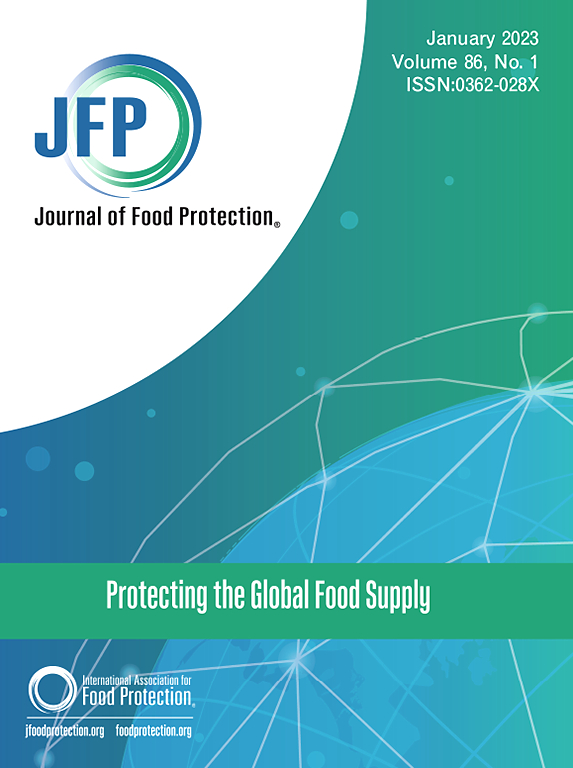评估Ɛ-聚赖氨酸、过氧化氢和月桂精氨酸抑制单核细胞增多性李斯特菌生物膜形成和灭活成熟生物膜的功效。
IF 2.1
4区 农林科学
Q3 BIOTECHNOLOGY & APPLIED MICROBIOLOGY
引用次数: 0
摘要
防止单核细胞增生李斯特菌的引入、随后的生物膜形成以及在食品加工环境中的持续存在,对于降低即食食品的交叉污染风险非常重要。本研究确定了Ɛ-聚赖氨酸(EPL)、过氧化氢(HP)和月桂精氨酸(LAE)对单核细胞增多性李斯特菌生物膜形成和成熟生物膜失活的影响。在抑制研究中,在亚抑制浓度(SIC)的 EPL(10 ppm)、HP(2 ppm)或 LAE(1.5 ppm)存在下,单核细胞增生性酵母菌 Scott A(血清型 4b)和 2014L-6025(1/2b)的生物膜在 37°C 下分别在聚苯乙烯板和不锈钢圆片上形成 48 小时。将每个表面上的成熟生物膜暴露于最低杀菌浓度 (MBC)、10xMBC 或 100xMBC 的每种抗菌剂中,在 37°C 下放置 24 小时,即可确定其是否失活。在 SIC 条件下使用这些抗菌剂并不能抑制两种表面上生物膜的形成,而且它们对成熟生物膜的影响因菌株和表面而异。与 HP(40 ppm)和 LAE(5 ppm)相比,在 1xMBC 的相同条件下,施用 1xMBC (100 ppm)的 EPL 24 小时后,两种菌株在聚苯乙烯上的计数减少幅度更大(P ≤ 0.0243)。将成熟的生物膜暴露在 10xMBC (50 ppm)的 LAE 中 1 小时,比在相同时间内暴露在 10xMBC (400 ppm)的 HP 中更能有效减少聚苯乙烯上的计数(P ≤ 0.0136);与 EPL(10,000 ppm)相比,在 100xMBC (分别为 4000 和 500 ppm)条件下使用 HP 和 LAE 24 小时,能更有效地灭活聚苯乙烯上的单核细胞增多性梭状芽孢杆菌 A 的成熟生物膜(P ≤ 0.0307)。与 10xMBC 的 EPL(1,000)或 HP(P ≤ 0.0430)相比,施用 10xMBC 的 LAE 24 小时对灭活不锈钢上的 Scott A 菌株更有效。今后还需要进行研究,以确定这些抗菌剂和其他抗菌剂在食品生产和储存相关温度下对其他单核细胞增多症菌株和血清型的功效。本文章由计算机程序翻译,如有差异,请以英文原文为准。
Evaluating the Efficacy of Ɛ-poly-lysine, Hydrogen Peroxide, and Lauric Arginate to Inhibit Listeria monocytogenes Biofilm Formation and Inactivate Mature Biofilms
Preventing the introduction of Listeria monocytogenes, subsequent biofilm formation, and persistence in food processing environments is important for reducing the risk of cross-contamination of ready-to-eat foods. This study determined the effect of Ɛ-poly-lysine (EPL), hydrogen peroxide (HP), and lauric arginate (LAE) on L. monocytogenes biofilm formation and the inactivation of mature biofilms. For inhibition studies, biofilms of L. monocytogenes Scott A (serotype 4b) and 2014L-6025 (serotype 1/2b) were developed separately at 37 °C for 48 h in the presence of sub-inhibitory concentrations (SIC) of either EPL (10 ppm), HP (2 ppm), or LAE (1.5 ppm) on polystyrene plates and stainless-steel rounds. Inactivation was determined by exposing mature biofilms on each surface to each antimicrobial at their minimum bactericidal concentration (MBC), 10xMBC, or 100xMBC for 24 h at 37 °C. The presence of these antimicrobials at SIC did not inhibit biofilm formation on either surface and their effect on mature biofilms varied by strain and surface. Application of EPL at 1xMBC (100 ppm) for 24 h resulted in greater reductions in counts of both strains on polystyrene than HP (40 ppm) and LAE (5 ppm) under the same conditions at 1xMBC (P ≤ 0.0243). Exposure of mature biofilms to LAE at 10xMBC (50 ppm) for 1 h was more effective in reducing counts on polystyrene than HP at 10xMBC (400 ppm) for the same duration (P ≤ 0.0136), and both HP and LAE applied at 100xMBC (4,000 and 500 ppm, respectively) for 24 h more effectively inactivated mature biofilms of L. monocytogenes Scott A on polystyrene compared to EPL (10,000 ppm) (P ≤ 0.0307). Application of LAE at 10xMBC for 24 h was more effective at inactivating strain Scott A on stainless steel compared to 10xMBC of EPL (1,000 ppm) or HP (P ≤ 0.0430). Future studies are needed to determine the efficacy of these and other antimicrobials on additional strains and serotypes of L. monocytogenes at temperatures relevant to food production and storage.
求助全文
通过发布文献求助,成功后即可免费获取论文全文。
去求助
来源期刊

Journal of food protection
工程技术-生物工程与应用微生物
CiteScore
4.20
自引率
5.00%
发文量
296
审稿时长
2.5 months
期刊介绍:
The Journal of Food Protection® (JFP) is an international, monthly scientific journal in the English language published by the International Association for Food Protection (IAFP). JFP publishes research and review articles on all aspects of food protection and safety. Major emphases of JFP are placed on studies dealing with:
Tracking, detecting (including traditional, molecular, and real-time), inactivating, and controlling food-related hazards, including microorganisms (including antibiotic resistance), microbial (mycotoxins, seafood toxins) and non-microbial toxins (heavy metals, pesticides, veterinary drug residues, migrants from food packaging, and processing contaminants), allergens and pests (insects, rodents) in human food, pet food and animal feed throughout the food chain;
Microbiological food quality and traditional/novel methods to assay microbiological food quality;
Prevention of food-related hazards and food spoilage through food preservatives and thermal/non-thermal processes, including process validation;
Food fermentations and food-related probiotics;
Safe food handling practices during pre-harvest, harvest, post-harvest, distribution and consumption, including food safety education for retailers, foodservice, and consumers;
Risk assessments for food-related hazards;
Economic impact of food-related hazards, foodborne illness, food loss, food spoilage, and adulterated foods;
Food fraud, food authentication, food defense, and foodborne disease outbreak investigations.
 求助内容:
求助内容: 应助结果提醒方式:
应助结果提醒方式:


